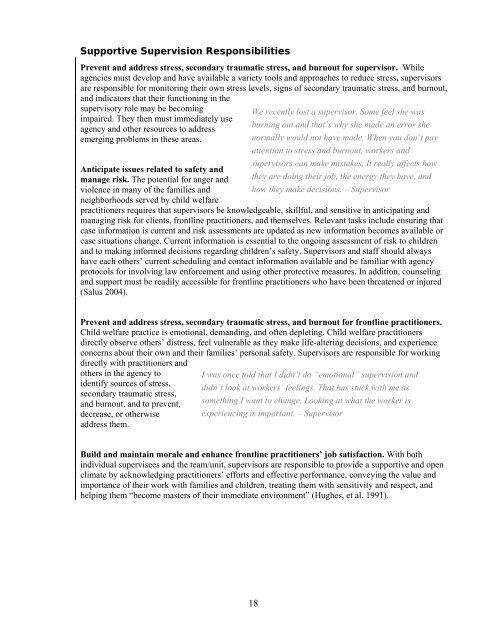Building a Model and Framework for Child Welfare Supervision
Building a Model and Framework for Child Welfare Supervision
Building a Model and Framework for Child Welfare Supervision
- No tags were found...
Create successful ePaper yourself
Turn your PDF publications into a flip-book with our unique Google optimized e-Paper software.
Supportive <strong>Supervision</strong> ResponsibilitiesPrevent <strong>and</strong> address stress, secondary traumatic stress, <strong>and</strong> burnout <strong>for</strong> supervisor. Whileagencies must develop <strong>and</strong> have available a variety tools <strong>and</strong> approaches to reduce stress, supervisorsare responsible <strong>for</strong> monitoring their own stress levels, signs of secondary traumatic stress, <strong>and</strong> burnout,<strong>and</strong> indicators that their functioning in thesupervisory role may be becomingWe recently lost a supervisor. Some feel she wasimpaired. They then must immediately useagency <strong>and</strong> other resources to addressburning out <strong>and</strong> that’s why she made an error sheemerging problems in these areas.normally would not have made. When you don’t payattention to stress <strong>and</strong> burnout, workers <strong>and</strong>supervisors can make mistakes. It really affects howAnticipate issues related to safety <strong>and</strong>manage risk. The potential <strong>for</strong> anger <strong>and</strong> they are doing their job, the energy they have, <strong>and</strong>violence in many of the families <strong>and</strong> how they make decisions. – Supervisorneighborhoods served by child welfarepractitioners requires that supervisors be knowledgeable, skillful, <strong>and</strong> sensitive in anticipating <strong>and</strong>managing risk <strong>for</strong> clients, frontline practitioners, <strong>and</strong> themselves. Relevant tasks include ensuring thatcase in<strong>for</strong>mation is current <strong>and</strong> risk assessments are updated as new in<strong>for</strong>mation becomes available orcase situations change. Current in<strong>for</strong>mation is essential to the ongoing assessment of risk to children<strong>and</strong> to making in<strong>for</strong>med decisions regarding children’s safety. Supervisors <strong>and</strong> staff should alwayshave each others’ current scheduling <strong>and</strong> contact in<strong>for</strong>mation available <strong>and</strong> be familiar with agencyprotocols <strong>for</strong> involving law en<strong>for</strong>cement <strong>and</strong> using other protective measures. In addition, counseling<strong>and</strong> support must be readily accessible <strong>for</strong> frontline practitioners who have been threatened or injured(Salus 2004).Prevent <strong>and</strong> address stress, secondary traumatic stress, <strong>and</strong> burnout <strong>for</strong> frontline practitioners.<strong>Child</strong> welfare practice is emotional, dem<strong>and</strong>ing, <strong>and</strong> often depleting. <strong>Child</strong> welfare practitionersdirectly observe others’ distress, feel vulnerable as they make life-altering decisions, <strong>and</strong> experienceconcerns about their own <strong>and</strong> their families’ personal safety. Supervisors are responsible <strong>for</strong> workingdirectly with practitioners <strong>and</strong>others in the agency to I was once told that I didn’t do “emotional” supervision <strong>and</strong>identify sources of stress,didn’t look at workers’ feelings. That has stuck with me assecondary traumatic stress,<strong>and</strong> burnout, <strong>and</strong> to prevent, something I want to change. Looking at what the worker isdecrease, or otherwise experiencing is important. – Supervisoraddress them.Build <strong>and</strong> maintain morale <strong>and</strong> enhance frontline practitioners’ job satisfaction. With bothindividual supervisees <strong>and</strong> the team/unit, supervisors are responsible to provide a supportive <strong>and</strong> openclimate by acknowledging practitioners’ ef<strong>for</strong>ts <strong>and</strong> effective per<strong>for</strong>mance, conveying the value <strong>and</strong>importance of their work with families <strong>and</strong> children, treating them with sensitivity <strong>and</strong> respect, <strong>and</strong>helping them “become masters of their immediate environment” (Hughes, et al. 1991).18
















